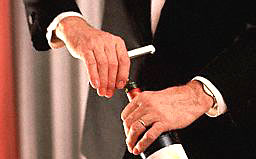


The first corkscrew, it is believed, was adapted from a worm-like steel device made to extract bullets from guns. The corkscrew (or bottle screw) became necessary when the habit of corking bottles became widespread in the 18th century.
Cork is used to seal nearly every bottle of wine, apart from those holding simple wines, which are sold with screw caps. It has been found to be the best form of closure, despite the difficulties and costs inherent in dealing with a natural rather than synthetic material. Cork is cut from the bark of a particular kind of oak tree, an evergreen found in the western Mediterranean lands and Portugal.
The virtues of cork are that it is impermeable and elastic, and takes up the shape of the neck of the bottle, thus forming an excellent seal. It will last a very long time, and it is unaffected by changes in temperature. The only things that affect corks are dryness — if a bottle is stood upright, rather than horizontally, the cork will dry out — and various bacteriological and insect pests. Corks are sterilized before use to combat these, but a tiny proportion of corks will develop mould which can penetrate the cork and taint the wine. This is the origin of the term "corked" or "corky". Wine from such a bottle will smell unmistakably flat, musty and unpleasant. A few fragments of cork floating in a wine do not mean it is "corked".
|
|
|



